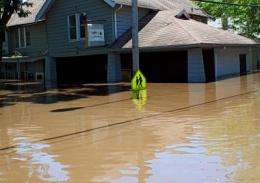Model aims to reduce disaster toll on city's social, economic fabric

Researchers have created a computer model that predicts how a disaster's impact on critical infrastructure would affect a city's social and economic fabric, a potential tool to help reduce the severity of impacts, manage the aftermath of catastrophe and fortify infrastructure against future disasters.
"The model works for any type of disaster that influences the infrastructure," said Makarand Hastak, head of construction engineering and management and a professor of civil engineering at Purdue University. "If we can identify in advance the most vulnerable elements of the critical infrastructure, then we can take proactive measures to reinforce them or at least find alternatives."
The model simulates how a disaster affects elements such as bridges, roads, municipal water and wastewater treatment services, along with vital economic and social components such as employers, hospitals, schools and churches.
"It can be most effectively used as a planning tool before a disaster because it enables you to put preventative measures in place," said Hastak, who is working with doctoral student Abhijeet Deshmukh. "But it can also be used while the disaster is unfolding to anticipate what will happen next and make decisions about where to evacuate and where to direct disaster relief, as well as after the disaster is over to assess the economic and social impacts."
The model was created by Eun Ho "Daniel" Oh, a former Purdue doctoral student who is a research specialist at the Korea Institute of Construction Technology in Seoul.
The researchers demonstrated their prototype on several cities, including Cedar Rapids, Iowa, which was hit by a devastating flood in the summer of 2008.
Findings on how to quantify impacts from disasters will be presented during the International Conference on Disaster Management on Nov 15 and 16 at the University of Hawaii at Manoa, Honolulu. The paper was written by Hastak, Oh, Deshmukh and J. Eric Dietz, director of the Purdue Homeland Security Institute and an associate professor of computer and information technology.
Related publications written by Deshmukh, Oh and Hastak, show how the model was used to study 2008 flood damage to infrastructure in St. Louis, Gulfport and Des Plaines, Ill., and Terre Haute, Ind.
Cedar Rapids, however, sustained the brunt of the disaster, which exceeded a 500-year flood, blocking access to the city's government center and overwhelming the Cedar River, which is vital for industry, commerce and transportation.
"Cedar Rapids is a good case study because it relies on a major river," Hastak said.
The research was funded by the National Science Foundation's Infrastructure Management and Extreme Events program. The simulation model is called a "disaster impact mitigation support system."
"The model helps you identify the most vulnerable parts of the infrastructure so that a community can target spending in preparing for a disaster," Deshmukh said. "For electricity, you could have generators; you could have alternatives for water or wastewater; for transportation and the supply chain, you could have a warehouse that stores products away from the river."
Provided by Purdue University
















